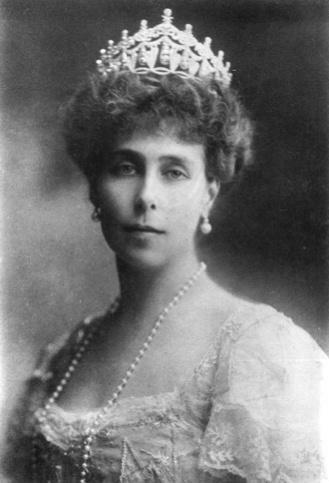Victoria - Melita was born in 1876 in the family of the second son of Queen Victoria, Duke Alfred of Edinburgh and the daughter of Emperor Alexander II, Grand Duchess Maria Alexandrovna. Victoria grew up in Malta, for which she received from her parents the middle name Melita - in honor of the historical name of the island. On April 19, 1894, the princess was married to the Grand Duke of Hesse - Darmstadt , Ernest-Ludwig. Their marriage was annulled in 1901. Being familiar from childhood with the Grand Duke Kirill Vladimirovich, Victoria- Melita , after a divorce, established a love relationship with him. However, almost the entire imperial family opposed the marriage between them. On October 8, 1905, the wedding of Cyril and Victoria- Melita took place in the Orthodox Church of St. Nicholas in Tegernsee . Initially, their union was severely criticized, but only on July 15, 1907, Emperor Nicholas II recognized the marriage of his cousin and cousin. In addition, in January 1907, the princess converted to Orthodoxy with the name Victoria Feodorovna. Being outside of Russia, the couple had two daughters - Maria (1907) and Kira (1909). In 1910, Grand Duchess Victoria Feodorovna finally moved to Russia. There she became a member of the Council of the Imperial Women's Patriotic Society and was a trustee of the School named after the heir to Tsarevich Alexei Nikolaevich. During the First World War, the princess organized the “Automotive Detachment of Her Imperial Highness Grand Duchess Victoria Feodorovna”, which was engaged in the evacuation of people. Under the auspices of the International Red Cross, she was also engaged in the search for prisoners of war and the arrangement of fraternal cemeteries for those killed in battle and those who died in hospitals. Often traveled to the front to provide humanitarian assistance. After the February Revolution of 1917, Victoria Feodorovna left for Finland, where her son Vladimir was born in August.¹
In Finland, the Civil War began in 1918, which called into question the safety of the grand ducal family. Two years later, Victoria and Cyril were able to leave Finland and move to relatives in Germany. Since 1921 they began to live in Cannes. Grand Duchess Victoria helped the Munich Legitimist monarchists organize the “Supreme Legitimist Council”. Victoria Fedorovna and her august husband maintained ties with the Young Russians and their leader Alexander Kazem -Bek. In fact, she pushed Kazem -Bek to create an organization.
In June 1924 the family moved again, this time to Coburg . In November 1924, Empress Victoria Feodorovna visited the United States at the invitation of the Ladies' Benevolent Club to raise money for Russian emigrants. In the late 1920s, the family settled in Saint -Briac , followed by the Office of His Imperial Majesty in 1929. Victoria Fedorovna and her august husband maintained ties with the Young Russians . It was believed that Victoria Fedorovna was the secret patron of the Aufbau association.²
In July 1929, Metropolitan Anthony (Khrapovitsky) visited the imperial family in Saint -Briac . By 1935, the health of the Empress in exile had deteriorated noticeably. Victoria Feodorovna was not an opponent of the Nazi regime in Germany. On March 2, 1936, Empress Victoria Feodorovna died.³
In Finland, the Civil War began in 1918, which called into question the safety of the grand ducal family. Two years later, Victoria and Cyril were able to leave Finland and move to relatives in Germany. Since 1921 they began to live in Cannes. Grand Duchess Victoria helped the Munich Legitimist monarchists organize the “Supreme Legitimist Council”. Victoria Fedorovna and her august husband maintained ties with the Young Russians and their leader Alexander Kazem -Bek. In fact, she pushed Kazem -Bek to create an organization.
In June 1924 the family moved again, this time to Coburg . In November 1924, Empress Victoria Feodorovna visited the United States at the invitation of the Ladies' Benevolent Club to raise money for Russian emigrants. In the late 1920s, the family settled in Saint -Briac , followed by the Office of His Imperial Majesty in 1929. Victoria Fedorovna and her august husband maintained ties with the Young Russians . It was believed that Victoria Fedorovna was the secret patron of the Aufbau association.²
In July 1929, Metropolitan Anthony (Khrapovitsky) visited the imperial family in Saint -Briac . By 1935, the health of the Empress in exile had deteriorated noticeably. Victoria Feodorovna was not an opponent of the Nazi regime in Germany. On March 2, 1936, Empress Victoria Feodorovna died.³
Grand Duchess Victoria Feodorovna (1876–1936)

Grand Duchess Victoria Feodorovna (1876–1936)
Source
Source

Content Oriented Web
Make great presentations, longreads, and landing pages, as well as photo stories, blogs, lookbooks, and all other kinds of content oriented projects.
[1] Zakatov, Aleksandr. “Tsarstvennaia Khudozhnitsa Viktoria Feodorovna.” Russian Art , no. 4, 2019, pp. 90–99.
[2] Massip, Mirey. Istina - doch' vremeni: Aleksandr Kazem-Bek i russkaya emigratsiya na Zapade . YAzyki slavyanskoy culture, 2010. P. 107,132,148, 222, 284.
[3] Zakatov, Aleksandr. “Tsarstvennaia Khudozhnitsa Viktoria Feodorovna.” Russian Art , no. 4, 2019, pp. 90–99.
[2] Massip, Mirey. Istina - doch' vremeni: Aleksandr Kazem-Bek i russkaya emigratsiya na Zapade . YAzyki slavyanskoy culture, 2010. P. 107,132,148, 222, 284.
[3] Zakatov, Aleksandr. “Tsarstvennaia Khudozhnitsa Viktoria Feodorovna.” Russian Art , no. 4, 2019, pp. 90–99.